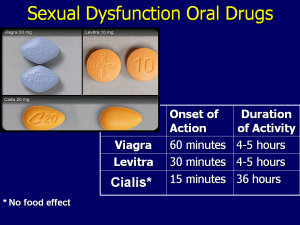
Introduction
Celebrating its 18th anniversary since receiving FDA approval, Sildenafil, widely recognized as Viagra, has become a stalwart in addressing erectile dysfunction (ED) among men. Yet, this notable drug began its journey with a mission to alleviate cardiovascular issues before becoming synonymous with enhancing sexual vitality. This article unfolds the transformation of Sildenafil, shedding light on its origin, its impact on cardiovascular and sexual health, and its potential in managing other health conditions.
A Leap in Cardiovascular Treatment: The Discovery of cGMP and PDE5 Inhibitors
The 1986 discovery of nitric oxide (NO) served as a springboard for innovative drug development. Recognized as a powerful vasodilator, NO relaxes blood vessels and promotes blood flow, playing a pivotal role in regulating blood pressure, averting atherosclerosis, and sustaining penile erection^1^. Its ability to modulate blood pressure is achieved through the creation of cyclic guanosine monophosphate (cGMP). The enzyme phosphodiesterase enzyme 5 (PDE-5), which halts cGMP, is usually found in elevated levels among individuals battling conditions like heart failure or ventricular hypertrophy.
The emergence of PDE-5 inhibitors like Sildenafil heralded a new era in addressing circulatory issues, presenting a viable solution for restoring and sustaining healthy circulation, especially among cardiovascular disease patients^2^.
Unveiling a Surprising Benefit: Pfizer’s Path to Unearthing Viagra
By the early ’90s, pharmaceutical giant Pfizer had conducted numerous trials on sildenafil citrate for angina treatment. Although the results didn’t demonstrate sufficient efficacy, the data revealed a serendipitous finding—volunteers reported enhanced erections post-drug administration. Encouraged by this, Pfizer initiated pilot studies for ED, eventually securing a US patent for sildenafil citrate in 1996. By March 1998, the FDA had approved it for ED treatment, and Viagra entered the market, revolutionizing ED therapy.
The Ubiquity of Erectile Dysfunction and the Rise of PDE-5 Inhibitors
Erectile dysfunction is a pervasive issue, impacting millions globally with over half the male population above 40 experiencing varying degrees of ED^3^. Among the myriad treatment alternatives, PDE-5 inhibitors have emerged as the preferred choice for physicians, owing to their efficacy in enhancing blood flow and muscle relaxation for improved erections.
Safety Concerns and Subsequent Vindication
The initial years post-Viagra’s launch witnessed concerns surrounding its safety, particularly after a 2000 study presented findings of 522 Viagra-related deaths within the first year of its market entry^4^. However, subsequent research robustly established the safety and tolerability of PDE-5 inhibitors, showcasing mild side-effects^5^,^6^.
Beyond ED: The Multifaceted Potential of PDE-5 Inhibitors
Further studies have revealed the diverse therapeutic potential of PDE-5 inhibitors, from managing pulmonary arterial hypertension^8^, alleviating diabetic-induced oxidative stress^9^, to even potentially preventing type 2 diabetes. These inhibitors have also shown promise in treating benign prostatic hyperplasia^11^ and aiding in hormonal regulation that underpins erectile function^10^.
Conclusion
The trajectory of Sildenafil from a cardiovascular aid to a linchpin in combating ED underscores the dynamic potential of medical discoveries. As research continues to unveil new facets of PDE-5 inhibitors, the legacy of Sildenafil extends beyond being a “little blue pill,” offering hope for numerous medical conditions.
References:
^1^ Musicki B, et al. Mol Pharmacol.(2005)
^2^ Chester AH, et al. Lancet. (1990)
^3^ Olsson AM, et al. International Journal of Clinical Practice. (2000)
^4^ Kaul S, WebMd, (2000)
^5^ Steers W, et al. Int J Impot Res. (2001)
^6^ Brock G, et al. J Urol. (2003)
^7^ Kukreja RC, Br J Pharmacol. (2007)
^8^ Galie N, et al. N Engl J Med.(2005)
^9^ Milani E, et al. Comp Biochem Physiol C Toxicol Pharmacol. (2005)
^10^ Greco EA, et al. J Sex Med. (2006)
^11^ Uckert S, et al. Eur Urol. (2006)
^12^ Atan A, et al. Urology. (2006)







